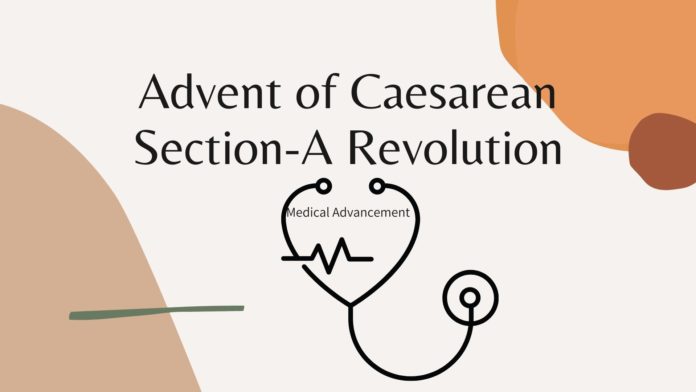It is said that,giving birth to a child is almost comparable to a rebirth of the woman.A woman undergoes a gamut of emotions and a widely ranged physical transformation throughout the pregnancy and slowly,her body gears up for the culmination of pregnancy marked by the major event of parturition ie.delivery.
Need of Advent of Caesarean Section
The delivery or the process of labour is a complex and excruciating process for the mother involving the orchestration of a series of physiological events which are accompanied by a cascade of endocrine changes that terminate with a successful delivery.Though a woman’s body is designed to give birth and things take the expected course most times,sometimes,some complications arise during pregnancy(antenatally) or during labour(in the intrapartum stage),making it almost impossible to deliver the baby normally,without risking the baby’s or the mother’s lives.
But, due to lack of medical research in the ancient times, any such minor obstetric complications in the intrapartum stage also would lead to the death of the mother invariably.Then, to retrieve the live foetus from the dead or dying mother, the mother’s abdomen was cut and the baby was delivered, known as Caesarean operation during those days.This method has undergone many milestone changes in its procedure and objective to be practiced in the way it is today.
References in Ancient Folklore
The roots of this procedure can be traced back to ancient texts and folklore belonging to different parts of the world like India, Greece, Rome, Iran, China etc.However, this procedure was only employed only in a limited objective of saving the child when the pregnant mother was dead or dying, or also as a means of separating them for religious burial if neither survived.This objective was evident in the Roman decree, part of a law called as “Lex Caesarea”.
The etymology of the word “Caesarean operation” involves a legend about birth of Julius Caesar.The Byzantine encyclopedia “the Suda”states that when mother of Julius Caesar died, they cut her open and took him out and thus named him Caesar.However, this seems unlikely, as the mother of Caesar ie.Aurelia survived his birth.The most tenable explanation for the name “Caesarean” could be its relation to various forms of the latin word “Caedere”, which means to cut.
According to a tale in Indian history,mother of Bindusara(emperor of Mauryan dynasty)accidently consumed poison and died when she was in the parturient stage.Chanakya cut open the abdomen of the queen and delivered the baby in order to save the life of the heir of the throne.
The ancient Ayurvedic treatise on surgery, the Sushruta Samhita, describes concisely the procedure and indications to extract the foetus from the abdomen of the mother.
Leizhong,a descendant of the “Yellow Emperor” had six sons, all born by cutting open the womb, as per the ancient records of the Grand Historian.Also,Babylonian Talmud, a Jewish religious text and a book named “Shahnameh” in Iran also bear mentions of Caesarean sections being performed as early as 1000 AD.
Research Conducted Around 16th Centaury
In 1581, a French medical expert, François Rousset, published a treatise advocating the procedure to be carried out on a living woman too. He described it as “enfantement Cesarien”or caesarean birth. He recommended this operative as the last resort to save a parturient in an extraordinary medical condition, presenting ten observations and evidence to prove that this intervention is feasible and could save lives of both the mother and the child, also preserving the possibility of further pregnancy. But, like many other extraordinary findings, this proposal was coldly received and also vigorously opposed by medical milieu. It was considered as an intervention entailing death and thus was left unacknowledged for a long time.
The operation was known by the name “Caesarean operation”until another French surgeon, Jacques Gullimeau, introduced the term “Caesarean section “in his book on midwifery in 1598.
However, since Renaissance, the grim circumstances took a positive turn and the objective of performing caesarean section gradually shifted from being a postmortem procedure to being a procedure done to prevent maternal morbidity and mortality.
Further Advancements
For until 18thcentury, the procedure exhibited a high mortality rate of upto 85%.Conducting the surgery was a tedious job and its after effects were perilous. The surgery resulted into introduction of foreign microbes and instruments into the abdomen, thus resulting into severe infection and sepsis.Occurence of postpartum hemorrhages was frequent and there was no remedy known to control it.Considering such poor prognosis, patients tried to avoid the surgery by hook or crook. Inabsolute indications for the surgery like severe Cephalopelvic Disproportion (woman having small pelvic dimensions as compared to the head of the baby), the mother was advised to under nourishherself, thus resulting in a smaller foetus and avoiding the surgery. In obstructed labour, forceps were widely used, causing trauma to the baby. Also, absence of anesthesia made matters worse. The introduction of non-sterile hands of the surgeon and theinstruments, no suturing and inadequate cleanliness maintained by surgeons due to lack of awareness made it a very unreliable and barbaric procedure.
However, some key introductions to the medical field in the mid-1800s proved to be milestones in the field of surgery.The Hungarian physician Ignac Semmelweis was able to prove that a simple step of hand washing prior to the surgery can have an antiseptic effect and prevent passage of infection to the patient and thus other major complications like puerperal fever.The major discovery that a microorganism could cause a disease was credited to the Frenchman Casimir Davaine. Inhalational gases for anesthesia like chloroform, ether and methods of sterilizing the instruments were eventually developed and undergo modifications even today.Suturing materials (first of silver) were invented and surgical techniques advanced further, making this surgery more simple and safe.
Evolution in Surgical Techniques
In the late 1800s, many different methodologies for abdominal delivery were prevalent. The earliest of these was developed by the Italian obstetrician Eduardo Porro which included supracervical hysterectomy along with the delivery of the baby ie.removal of the part of the uterus present above the level of cervix. After this procedure, the woman could not bear any more children and hence its popularity waned away.
In 1882, Max Sanger perfected a method of incising the uterus vertically along its body and extracting the baby out, terming it as “Classical or Corporeal caesarean section “and also introduced suturing of the uterus after the surgery. However this method exhibited significant complications like hemorrhage, intraperitoneal adhesions and the possibility of rupture of the uterus in the subsequent pregnancy.
Around the same time, a third technique was developed by another gynecologist, Ferdinand Adolph Kehrer,proposing to enter the uterus by incising at the lower segment, reducing the bleeding significantly and the incision was easily closed too. Hermann Johannes Pfannenstiel modified this technique into the lower segment Caesarean section (LSCS), the most commonly used type of Caesarean section today and it was popularized by Dr. Monroe Kerr.In this method, a transverse incision is made in the lower uterine segment above the attachment of the urinary bladder to the uterus. This type of incision results in minimal blood loss and is easier to repair due to less vascularity on the lower segment of the uterus and thus, is widely accepted and utilized in practice today.
Utility in Present time
The use of caesarean sections can be either ‘elective’ or ‘in an emergency’.
Emergency Caesarean sections
They can also be classified into three categories, based on their urgency, as follows:
Category 1- Immediate threat to the life of the woman or foetus
Category 2- Maternal or fetal compromise, but not immediately life threatening
Category 3- No maternal or fetal compromise, but early delivery needed.
Indictions for emergency caesarean can be conditions like non progression of labour, cord prolapse, uterinerupture; abruption of placenta, etc.which cannot be managed by any other way but to terminate the pregnancy by caesarean section.
Elective Caesarean sections
Delivery through LSCS is planned during pregnancy itself if indications like Malpresentation of the baby, Pregnancy induced hypertension, twin pregnancy, maternal diabetes, genital herpes, placenta previa are present in the mother.
However,nowadays,the trend of elective LSCS is on the rise,which also is a matter of concern.Though the dramatic rise in numbers of caesarean sections can be attributed to multiple reasons like increasing number of women with prior caesarean delivery,consistent use of intrapartum electronic fetal monitoring, medico legal concerns and maternal autonomy in decision making regarding mode of delivery ,it is essential to note that caesarean section cannot be an alternative to the naturally established event of normal delivery and should be used cautiously only when it is indicated , to prevent its following complications.
The advent of caesarean section, however, has proved to be a boon to the obstetric field and revolutionized it by playing a very large role to reduce maternal and fetal morbidity and mortality over the last three centuries.
Author: Rujuta Joshi











